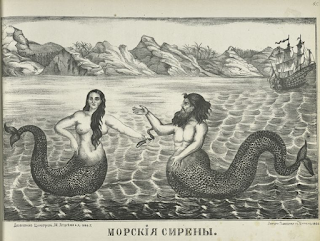 |
| Wikimedia commons |
[following on from the Exmouth report, 1812:] We subjoin the following particulars on this suject, from our common place book:--
The hav-manden and hav-fruen, the mer-man and mer-maid, are proposed as the first sea-monsters; which, in our author's, or his translator's words, are often seen in the north sea. Many fables, from different authors, concerning them, he quotes, and judiciously rejects; not doubting but the absurdities related of them have contributed to make sensible people deny their very existence. To those who admit a pretty general analogy between terrestrial and marine mammals, but suppose man, from the image after which he was formed, to be peculiarly exempted from this resemblance in the ocean, he recommends the consideration fo the wild man in the woods, which we call the Ouran-outan of Asia, or the Chimpenzie of Africa; but which our author, from Dapper's description of the latter, terms Quoyas Morrow, perhaps the name of it in Angola, where it is not infrequent, and from when we have seen this grave and surprising resemblance or mimick of the human form, not without some striking resemblance of the human faculties also.
The bishop, however, to compound with such readers as may find their pride wounded, perhaps, by the nominal affinity, is content if they will allow his mer-man, which the Norwegians call Hastromber, to be a sea-ape. This being adjusted, he informs us, that in the diocese of Bergen, and the manor of Nordland, are several hundred persons of credit and reputation, who affirm, with the strongest assurance, that they have seen this creature sometimes at a distance, and at other times close to their boats, erect and formed like a human creature down to the middle; the rest they could not see.
Our author has examined several of the witnesses with all possible precaution, and found them agree invariably with the description published by Jablonsky and Kircher. He brings an evidence who had seen one out of the water, and handled it, viz. the Rev. Mr. Peter Angel, minister at Sundmoer, living when this history was wrote, and who declares that in 1719, being then twenty years old, himself and several other inhabitants saw a mer-man, dead, on a point of land, with several sea-animals. Its length was three fathoms, its colour grey, the lower part like a fish, with a porpoise's tail. The face resembled a man's, with a mouth, forehead, eyes, &c. the nose was flat and pressed down to the face, in which the nostrils were very visible. The breast was near the head, the arms, which seemed to hang by the side, were joined by a thin membrane, and the hands, to appearance, were like the paws of a sea-calf.
Mr. Strom, another clergyman, informed him, that at Neroe, in Numedalen, a mer-man and a sea-calf were both found dead on a rock, all bloody, from whence it was conjectured they had killed each other. It is, indeed, analogous enough, that a sea-man should covet a repast of sea-yeal. Mr. Randulf, rector of the place, endeavoured to preserve the merman, but the peasants had unluckily cut both to pieces for the fat. In regard to size they differ remarkably, according to the fishermen, from that called mar-male, or mar-maete (the different sexes) which our author calls a well-known sea-animal, and thinks it may be a dwarf of the same species. -- This is often caught on hooks, is of different sizes, from that of a child of one year old, to three; and, the bishop thinks, till it is further enquired into, it may be supposed, though he does not affirm it to be, the infant of the former.
But the strongest and latest proof of the mer-man's existence happened in Denmark, and may properly conclude this article. On September 20, 1723, three ferrymen, viz. Peter Gunnersen, Nicholas Jensen, and Jappe Jensen, were, by his Majesty's orders, examined upon oath before Fred. Van Gram, privy-councellor, and deposed in substance, That two months before, being towing a ship arrived from the Baltic, at the distance of a quarter of a Norway mile, they rowed up to something floating like a dead body. When they came within seven or eight fathoms, it appeared as at first, for it had not stirred, but sunk at that instant, and came up again immediately almost at the same place.
Frightened at this, they lay still, and letting the boat float, the monster, by the help of the current, came still nearer to them. He turned his face, and stared at the men, which gave them a good opportunity of examining him narrowly. He stood in the same place for half a quarter of an hour, and was seen above the water down to his breast. At last, apprehending some danger, they began to retire, on which he blew up his cheeks, and made a kind of roaring noise, and dived, without rising in their sight.
He appeared to them like a strong-limbed, broad-shouldered old man, his head small in proportion, with short curled black hair, with a black beard, that looked like a cut one, his eyes deep in his head, his skin coarse, and very hairy. Gunnersen added (which the others did not observe) that from the body downwards he was quite pointed like a fish; and deposed, at the same time, that about twenty years before, he had seen near Kullebr, a mer-maid, with long hair and large breasts. The weather was fine and calm. That this examination was taken in the most regular and exact manner, is attested by Andrew Bussaeus.--
Monthly Review of Pontoppidan's Natural History of Norway.
In the Liverpool Mercury, September 4th, 1812.
No comments:
Post a Comment